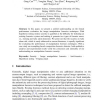Free Online Productivity Tools
i2Speak
i2Symbol
i2OCR
iTex2Img
iWeb2Print
iWeb2Shot
i2Type
iPdf2Split
iPdf2Merge
i2Bopomofo
i2Arabic
i2Style
i2Image
i2PDF
iLatex2Rtf
Sci2ools
122
Voted
PCM
2015
Springer
2015
Springer
On the Security of Image Manipulation Forensics
In this paper, we present a unified understanding on the formal performance evaluation for image manipulation forensics techniques. With hypothesis testing model, security is qualified as the difficulty for defeating an existing forensics system and making it generate two types of forensic errors, i.e., missing and false alarm detection. We point out that the security on false alarm risk, which is rarely addressed in current literatures, is equally significant for evaluating the performance of manipulation forensics techniques. With a case study on resampling-based composition forensics detector, both qualitative analyses and experimental results verify the correctness and rationality of our understanding on manipulation forensics security.
Multimedia | PCM 2015 |
Related Content
| Added | 16 Apr 2016 |
| Updated | 16 Apr 2016 |
| Type | Journal |
| Year | 2015 |
| Where | PCM |
| Authors | Gang Cao, Yongbin Wang, Yao Zhao, Rongrong Ni, Chunyu Lin |
Comments (0)

